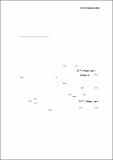Por favor, use este identificador para citar o enlazar a este item:
http://hdl.handle.net/10261/260468COMPARTIR / EXPORTAR:
 SHARE
BASE SHARE
BASE
|
|
| Visualizar otros formatos: MARC | Dublin Core | RDF | ORE | MODS | METS | DIDL | DATACITE | |

| Título: | Collagenolytic activity in macrophages is dependent on lysosomal protease cathepsin D during liver fibrosis |
Autor: | Pistorio, Valeria CSIC ORCID; Ruiz-Blázquez, Paloma CSIC ORCID; Fernández-Fernández, María CSIC; Nuñez, Susana CSIC; García-Ruiz, Carmen CSIC ORCID ; Fernández-Checa, José C. CSIC ORCID; Moles, Anna CSIC ORCID | Fecha de publicación: | 24-mar-2021 | Citación: | Extracellular Matrix Pharmacology Symposium (2021) | Resumen: | Background: Changes in proteolytic activity are essential to liver fibrosis development. During fibrosis there is a dysregulation between extracellular matrix (ECM) synthesis and degradation, resulting in excessive ECM accumulation. Previous reports suggest that macrophages are important effectors for ECM remodelling through phagocytosis and processing of ECM within acidic compartments. However, the role of macrophages in ECM remodelling during liver fibrosis is unknown. Objectives: Thus, the aim of this study was to investigate the proteolytic and degradative pathways associated to macrophages during liver fibrosis. Methods: To study the proteolytic and degradative signals contributing to fibrosis in macrophages we focused our attention on the lysosomal protease cathepsin D. Accordingly, we generated and validated a novel macrophage-CtsD knock-out mouse strain by breeding LysMCre (macrophages) with CtsD floxed mice. Peritoneal macrophage polarization from CtsDΔMyel+/+ or CtsDΔMyel-/- mice was achieved with LPS for M1 or IL4/IL13 for M2 stimulation. Polarization markers and MMP profile were assessed by real-time-PCR. Collagen degradation and endocytosis was studied using DQ™ Collagen, type I and 10KDa Dextran probes respectively, and WB for Endo180 and UPAR. Lysosomal colocalization was determined using LAMP2. Finally, fibrosis was established chronically by CCl4 (0.5μl/g) in CtsDΔMyel+/+ or CtsDΔMyel-/- mice and determined by SR staining, α-SMA IHP and Col1 WB as well as RT-PCR in total liver. Results: First, CtsD deletion in macrophages from CtsDΔMyel-/- mouse was confirmed by WB, CtsD activity in macrophages and dual IHP (F4/80-CtsD) in liver tissue. To note, cathepsin B expression remained unaffected despite deletion of CtsD. M1 and M2 polarization of CtsDΔMyel+/+ and CtsDΔMyel-/- macrophages using LPS (10 and 50 ng/mL) or IL4/IL13 (20 and 50 ng/mL) resulted in similar and significant induction of iNOS (M1) and CD206 (M2) gene expression respectively. However, while M1 downstream effector CCl2 was similarly induced between CtsDΔMyel+/+ and CtsDΔMyel-/- macrophages after LPS stimulation, IL10 was defectively induced in M2-primed CtsDΔMyel-/- macrophages. In addition, both, M1 and M2 CtsDΔMyel-/- macrophages displayed defective induction of MMP-2, -3 and -7 gene expression. CtsDΔMyel-/- macrophages showed a significant decrease in DQ™ Collagen, type I degradation versus CtsDΔMyel+/+ macrophages at 37C. As expected, no degradation was detected at 4C. Collagen degradative profile colocalized partially with LAMP2, indicating that collagen was degraded within the lysosome. Furthermore, Dextran endocytosis in both CtsDΔMyel+/+ and CtsDΔMyel-/- macrophages remained unaffected. CtsDΔMyel-/- demonstrated enhanced liver fibrosis as shown by an increase in Sirius red staining, alpha-SMA and Col1A1 gene and protein expression with no affectation of the Endo180/UPAR collagen internalization receptors (WB). Conclusion: Lysosomal cathepsin D is essential for a correct collagenolytic activity displayed by macrophages during liver fibrosis. | Descripción: | Trabajo presentado en el Extracellular Matrix Pharmacology Symposium, celebrado digitalmente los días 24 y 25 de marzo de 2021 | URI: | http://hdl.handle.net/10261/260468 |
| Aparece en las colecciones: | (IIBB) Comunicaciones congresos |
Ficheros en este ítem:
| Fichero | Descripción | Tamaño | Formato | |
|---|---|---|---|---|
| Checa - Extracellular Matrix Pharmacology Symposium (2021) - Collagenolytic activity in macrophages is dependent on lysosomal protease cathepsin D during liver fibrosis.pdf | 95,1 kB | Adobe PDF |  Visualizar/Abrir |
CORE Recommender
NOTA: Los ítems de Digital.CSIC están protegidos por copyright, con todos los derechos reservados, a menos que se indique lo contrario.
